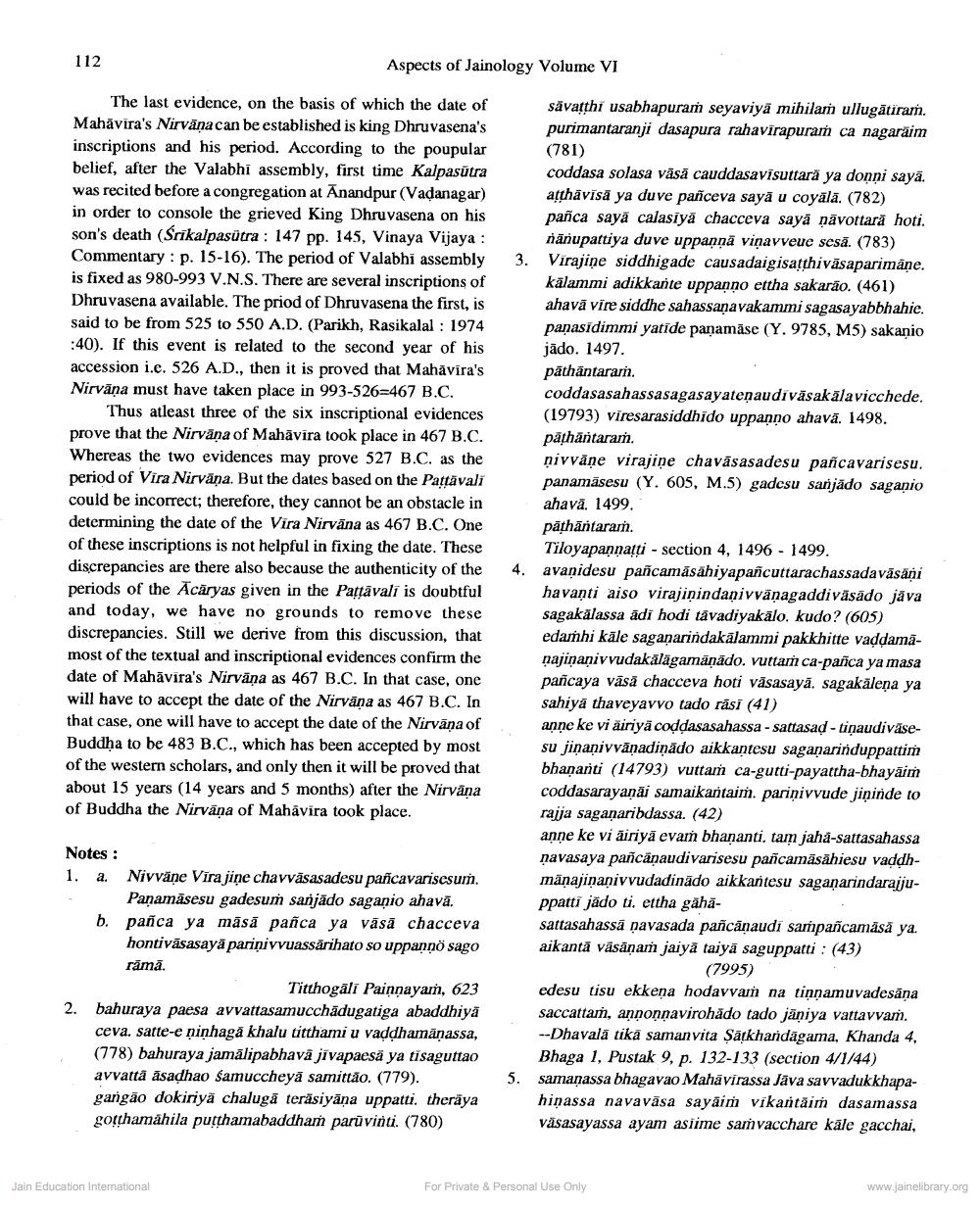Book Title: Reconsidering Date Of Nirvana Of Lord Mahavira Author(s): Sagarmal Jain Publisher: Z_Jaina_Literature_and_Philosophy_a_Critical_Approach_001936_HR.pdf View full book textPage 7
________________ 112 Aspects of Jainology Volume VI The last evidence, on the basis of which the date of Mahavira's Nirvana can be established is king Dhruvasena's inscriptions and his period. According to the poupular belief, after the Valabhi assembly, first time Kalpasūtra was recited before a congregation at Anandpur (Vadanagar) in order to console the grieved King Dhruvasena on his son's death (Srikalpasütra: 147 pp. 145, Vinaya Vijaya: Commentary: p. 15-16). The period of Valabhi assembly is fixed as 980-993 V.N.S. There are several inscriptions of Dhruvasena available. The priod of Dhruvasena the first, is said to be from 525 to 550 A.D. (Parikh, Rasikalal: 1974 :40). If this event is related to the second year of his accession i.c. 526 A.D., then it is proved that Mahavira's Nirvana must have taken place in 993-526-467 B.C. Thus atleast three of the six inscriptional evidences prove that the Nirvana of Mahāvīra took place in 467 B.C. Whereas the two evidences may prove 527 B.C. as the period of Vira Nirvana. But the dates based on the Paṭṭāvali could be incorrect; therefore, they cannot be an obstacle in determining the date of the Vira Nirvana as 467 B.C. One of these inscriptions is not helpful in fixing the date. These discrepancies are there also because the authenticity of the periods of the Acaryas given in the Paṭṭāvalī is doubtful and today, we have no grounds to remove these discrepancies. Still we derive from this discussion, that most of the textual and inscriptional evidences confirm the date of Mahavira's Nirvana as 467 B.C. In that case, one will have to accept the date of the Nirvana as 467 B.C. In that case, one will have to accept the date of the Nirvana of Buddha to be 483 B.C., which has been accepted by most of the western scholars, and only then it will be proved that about 15 years (14 years and 5 months) after the Nirvana of Buddha the Nirvana of Mahavira took place. Notes: 1. a. Nivväṇe Virajine chavväsasadesu pañcavarisesum. Paṇamasesu gadesum sanjado saganio ahavā. b. pañca ya māsā pañca ya vasa chacceva hontivāsasaya pariņivvuassarihato so uppanno sago rāmā. Titthogali Painnayam, 623 2. bahuraya paesa avvattasamucchadugatiga abaddhiyā ceva. satte-e ninhaga khalu titthami u vaḍdhamanassa, (778) bahuraya jamalipabhavā jīvapaesä ya tisaguttao avvatta asaḍhao Samuccheya samittão. (779). gangão dokiriya chaluga terasiyana uppatti. theraya gotthamahila putthamabaddham parūvinti. (780) Jain Education International savatthi usabhapuram seyaviyä mihilam ullugatiram. purimantaranji dasapura rahavirapuram ca nagaräim (781) coddasa solasa vāsā cauddasavisuttara ya donni sayä. atthävisǎ ya duve pañceva saya u coyālā. (782) pañca saya calasiya chacceva saya ṇāvottara hoti. nänupattiya duve uppannā viņavveue sesă. (783) 3. Virajine siddhigade causadaigisatthiväsaparimane. kālammi adikkante uppanno ettha sakarão. (461) ahavā vīre siddhe sahassanavakammi sagasayabbhahie. panasidimmi yatide panamase (Y. 9785, M5) sakanio jādo. 1497. pathantaran. coddasasahassasagasayatenaudivasakālavicchede. (19793) viresarasiddhīdo uppanno ahavā. 1498. pathantaram nivväṇe virajine chavasasadesu pañcavarisesu. panamāsesu (Y. 605, M.5) gadesu sanjado saganio ahavä, 1499. pāthāntaraṁ. Tiloyapannatti - section 4, 1496 1499. 4. avanidesu pañcamāsahiyapañcuttarachassadavāsāṇi havanti aiso virajinindanivvänagaddiväsädo jāva sagakalassa ādi hodi tavadiyakalo, kudo? (605) edamhi kale sagaṇarindakalammi pakkhitte vaddamānajinanivvudakalagamaṇādo. vuttam ca-pañca ya masa pañcaya vāsā chacceva hoti väsasaya. sagakāleṇa ya sahiya thaveyavvo tado rasi (41) anne ke vi äiriya coddasasahassa - sattasad-tinaudivasesu jiņaṇivväṇadiņādo aikkantesu saganarinduppattim bhananti (14793) vuttam ca-gutti-payattha-bhayaim coddasarayaṇai samaikantaim. pariņivvude jininde to rajja saganaribdassa. (42) anne ke vi äiriya evam bhananti. tam jaha-sattasahassa ṇavasaya pañcaṇaudivarisesu pañcamāsāhiesu vaḍdhmäṇajinaṇivvudadinado aikkantesu saganarindarajjuppatti jādo ti, ettha gähä sattasahassa ṇavasada pañcāṇaudī sampañcamāsǎ ya. aikantā vāsāṇam jaiyä taiyā saguppatti: (43) (7995) edesu tisu ekkena hodavvam na tinnamuvadesaṇa saccattam, annonṇavirohado tado jāņiya vattavvaṁ. --Dhavalā tika samanvita Satkhandagama, Khanda 4, Bhaga 1, Pustak 9, p. 132-133 (section 4/1/44) 5. samanassa bhagavao Mahavirassa Jäva savvadukkhapahiņassa navaväsa sayaim vikantaim dasamassa vasasayassa ayam asiime samvacchare kale gacchai, For Private & Personal Use Only www.jainelibrary.orgPage Navigation
1 ... 5 6 7 8 9
